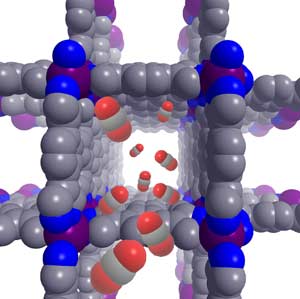$30 million from DOE for carbon capture, sequestration
Two University of California, Berkeley, faculty members will receive $30 million over the next five years from the U.S. Department of Energy to find better ways to separate carbon dioxide from power plant and natural gas well emissions and stick it permanently underground, according to an announcement yesterday (Monday, April 27) from the White House.
Berend Smit, a professor of chemical engineering and of chemistry, and Donald DePaolo, a professor of earth and planetary science and head of the Earth Sciences division at Lawrence Berkeley National Laboratory, will receive $2 million and $4 million, respectively, per year for the next five years. The funding will be used to set up two Energy Frontiers Research Centers (EFRC), which will be focused on carbon capture and sequestration.

The two centers are among 46 new EFRCs announced yesterday, with a total planned commitment by the DOE of $777 million over five years.
The announcement was made by the White House in conjunction with an address by President Obama to the National Academy of Sciences at its annual meeting in Washington, D.C., at which he pledged big increases in funding for scientific research. The EFRCs are among many other research efforts the administration is launching to "reinvigorate the American scientific enterprise through a bold commitment to basic and applied research, innovation and education," according to a White House statement.
"As global energy demand grows over this century, there is an urgent need to reduce our dependence on fossil fuels and imported oil and curtail greenhouse gas emissions," said Secretary of Energy Steven Chu, former LBNL director and UC Berkeley professor of physics, in a DOE statement. "Meeting this challenge will require significant scientific advances. These centers will mobilize the enormous talents and skills of our nation's scientific workforce in pursuit of the breakthroughs that are essential to make alternative and renewable energy truly viable as large-scale replacements for fossil fuels."
Smit's Center for Gas Separations Relevant to Clean Energy Technologies, to be funded by the DOE through the campus, aims to develop improved methods for extracting carbon dioxide from flue gases in power plant emissions, and from the methane in natural gas wells, so that the CO2 can be returned underground. Next generation carbon capture methods will have to be much more efficient than today's methods, which typically involve washing emissions and then extracting CO2 using up to 25 percent of the energy produced by the power plant, he said.
"We never hope that we need to use these next generation carbon capture methods; that solar and other alternatives are there in time," Smit said. "But if the worst possible scenario happens, that we decide to burn all tar sands and all coal that generate an enormous amount of CO2, then we want to have the technology available to put the CO2 into the ground in an efficient, cheap way that may buy us the essential time we need to develop alternative energy technologies."
The work involves computer modeling of new materials that more efficiently separate CO2 from other gases. Among the most promising materials are metal-organic frameworks, which are much like porous zeolites. With colleague Jeffrey Long, UC Berkeley professor of chemistry and faculty scientist at LBNL, Smit and their collaborators will then make and test these new materials to determine which chemical structures work best. Other collaborators are from LBNL, Texas A&M University, UCLA, the University of Amsterdam and the Norwegian University of Science and Technology.
DePaolo's Center for Nanoscale Control of Geologic CO2, to be funded through LBNL, will focus on the geological issues surrounding sequestration, primarily how CO2 interacts with the pores inside underground rocks and minerals. The goal of the research center is to eventually understand these interactions enough to achieve the most efficient filling of pore space when rocks deep underground are injected with high-pressure CO2, and to make sure that none of the CO2 leaks back into the atmosphere. These techniques could be used to predict the performance of any subsurface storage application for long periods of time.
"This new award will give our team of investigators an opportunity to probe the fundamental chemical, physical and biological processes that control the movement of carbon dioxide fluids in the earth," said DePaolo. "The EFRC gives us a framework under which we are able to combine the extraordinary talents that we have at Berkeley Lab, UC Berkeley, and our collaborating institutions to focus on a problem of global significance. In pursuing this new research, we will bring to bear many unique DOE research facilities, such as the Advanced Light Source, the Molecular Foundry, and the National Energy Research Scientific Computing Center at Berkeley Lab, and the Spallation Neutron Source at Oak Ridge."
DePaolo's LBNL team will collaborate with researchers at UC Davis, Lawrence Livermore National Laboratory, Oak Ridge National Laboratory and the Massachusetts Institute of Technology.
For further information:
Lawrence Berkeley National Laboratory press release
Department of Energy press release
